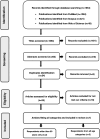Extended High-frequency Audiometry in the Elderly: A Narrative Review
- PMID: 39162007
- PMCID: PMC11363170
- DOI: 10.5152/iao.2024.231217
Extended High-frequency Audiometry in the Elderly: A Narrative Review
Abstract
Extended high-frequency audiometry (HFA) is considered an important tool in the detection of hearing loss. However, the values at extended high frequencies (EHF) in older adults (in both men and women) are associated with considerable uncertainty due to limited reference data. The presented review aimed to analyze hearing thresholds at EHF in adults older than 60 years. A literature search for HFA-related keyword combinations was conducted using the electronic databases PubMed, Scopus, and Web of Science. A total of 1654 records, published in the last 22 years, were identified through this search, of which only 7 articles were ultimately included in the analysis. Multiple studies have shown that significant hearing loss can be observed at EHF in older adults. Hearing thresholds in the frequency range of 9-20 kHz in the elderly varied widely across the studies. Therefore, further research in this field is needed to complete the normative data.
Conflict of interest statement
Figures


Similar articles
-
Extended High-Frequency Audiometry Using the Wireless Automated Hearing Test System Compared to Manual Audiometry in Children and Adolescents.Ear Hear. 2025 May-Jun 01;46(3):782-795. doi: 10.1097/AUD.0000000000001621. Epub 2024 Dec 26. Ear Hear. 2025. PMID: 39722183
-
Extended High-Frequency Smartphone Audiometry: Validity and Reliability.J Am Acad Audiol. 2019 Mar;30(3):217-226. doi: 10.3766/jaaa.17111. Epub 2018 Jan 18. J Am Acad Audiol. 2019. PMID: 30461416
-
The relationship of pulsed, continuous, and warble extended-high frequency thresholds.J Commun Disord. 1986 Jun;19(3):227-35. doi: 10.1016/0021-9924(86)90012-2. J Commun Disord. 1986. PMID: 3722436
-
A Systematic Review and Meta-Analysis of Extended High-Frequency Hearing Thresholds in Tinnitus With a Normal Audiogram.Ear Hear. 2022 Nov-Dec 01;43(6):1643-1652. doi: 10.1097/AUD.0000000000001229. Epub 2022 Oct 18. Ear Hear. 2022. PMID: 35612517
-
High-Frequency Audiometry for Early Detection of Hearing Loss: A Narrative Review.Int J Environ Res Public Health. 2021 Apr 28;18(9):4702. doi: 10.3390/ijerph18094702. Int J Environ Res Public Health. 2021. PMID: 33925120 Free PMC article. Review.
References
-
- World life expectancy 1950-2024. Available at: https://www.macrotrends.net/global-metrics/countries/WLD/world/life-expe....
-
- W orld Health Organization. 4 people projected to have hearing problems by 2050:1. Available at: https://www.who.int/news/item/02-03-2021-who-1-in-4-people-projected-to-....
-
- Deafness and hearing loss. Available at: https://www.who.int/health-topics/hearing-loss.
Publication types
MeSH terms
LinkOut - more resources
Full Text Sources
